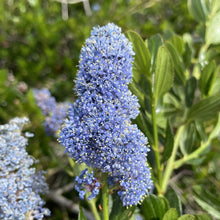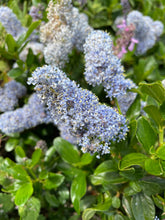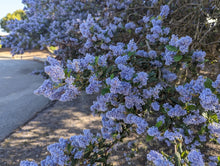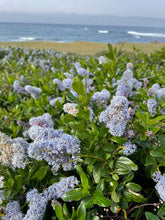
Ceanothus thyrsiflorus
Blue blossom Ceanothus, also known as mountain lilac, is a low-maintenance, large evergreen shrub with arching branches that bear year-round glossy green elliptic leaves and copious clusters of indigo flowers in the late spring. The spectacular floral display delights pollinators and eventually gives way to small purple or brown fruits that attract songbirds. Like other Ceanothus species, it fixes nitrogen in the soil, controls erosion, provides exceptional refugia habitat for birds and is drought tolerant and deer resistant once established.
- Plant type/canopy layer: large evergreen shrub or small evergreen tree
- Size at maturity: 8-23' tall, 6-18' wide
- Light requirements: full sun to part shade
- Moisture requirements: moist to dry soil, must be well-drained
- Bloom time: April - June
- Growth rate/ease: fast growing, easy to grow
- Wildlife support: flowers attract and provide nectar for hummingbirds, adult butterflies, bees and other insect pollinators; branches provide cover and fruits/seeds provide food for birds and small mammals; overall plant attracts and supports beneficial and pest eating insects and is a caterpillar host plant and larval food source for native butterflies and moths
- Native habitat/range: common in coastal and west-side forests of southwestern Oregon and northwestern California. Portland Plant List - no.
- Special features & uses: evergreen; hummingbird and pollinator magnet; wildlife favorite; drought tolerant; deer resistant; landscape uses include rock gardens, habitat hedgerows and open woodland garden edges
Gardening with Blue Blossom Ceanothus: This shrub is exceedingly low-maintenance, thriving in areas that get half to full day sunshine and a wide range of soil types including loamy, sandy, rocky, and clay soils - as long as they are well-drained. Once established, it is drought tolerant and excess water can result in fungal diseases. Lightly prune leafless interior branches and tips immediately after flowering, only if needed, to maintain a desired shape, but avoid heavy pruning as this will weaken its overall health and diminish its habitat value.
Photo Credits 1, 2 & 4 (flower closeups, on the beach): © Matt Berger, some rights reserved (CC-BY)
Photo Credit 3 (roadside): © Alexander Wentworth, some rights reserved (CC-BY)
Photo Credit 5 (as hedge): "Ceanothus thyrsiflorus thyrsiflorus" by Alexander Wentworth is licensed under CC BY 4.0.











